- The largest great ape, Grauer’s gorilla (Gorilla beringei graueri) has nearly disappeared in the past two decades. Numbers have plummeted by 77 percent; perhaps 3,800 remain. This animal, dubbed “the forgotten gorilla” because it was so little studied and was absent from most zoos, is in serious danger of extinction.
- Their slaughter was precipitated by the Democratic Republic of the Congo’s bloody civil war and by mining for coltan and tin ore, “conflict minerals” used in cell phones, laptops and other electronics. Gorillas are heavily poached by armed militias, miners, and less often, by refugees: the animals are being eaten nearly to extinction.
- The gorillas could suffer greater harm from warlords and miners if President Trump signs a proposed presidential memorandum leaked to Reuters. It would allow US companies to buy conflict minerals freely without public disclosure, likely increasing mining in the Congo basin — and poaching.
- Trump’s plan would nullify the current US Conflict Mineral Rule, passed with bipartisan support in 2010 and enacted as part of the Securities and Exchange Commission’s Dodd Frank Act. Meanwhile, conservationists are hopeful that the Grauer’s gorilla can be saved — but only with a DRC and planet-wide response.
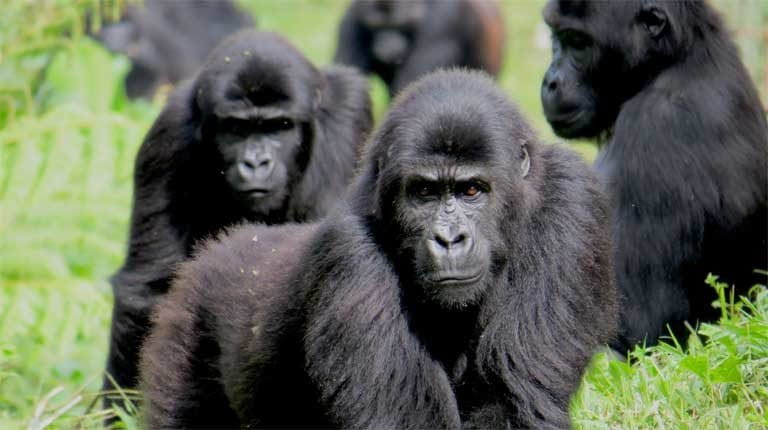
For weeks, the primatologists had followed a group of Grauer’s gorillas over rugged terrain — hacking through dense rainforest; following knife-edged ravines; and crossing a nearly impenetrable mountainous landscape in the eastern part of the Democratic Republic of the Congo (DRC).
Stuart Nixon, Chryso Kaghoma and their Congolese field team tracked Gorilla beringei graueri using GPS. They collected data on where the animals nested each night, what they ate, and other habits. But the researchers kept their distance, trailing a day behind the primate family, so as not to influence the group’s behavior or normalize them to people.
Or so the scientists thought. One day, while sitting quietly in the forest, Nixon heard the bushes move some 10 feet away. He looked up and into the blue-black face of a big silverback male. They made eye contact for a few very long seconds before the gorilla turned and ran off with the rest of his family back into the dense undergrowth.

It was a rare sighting of a great ape that was once dubbed “the forgotten gorilla” because it was so little studied and was absent from most of the world’s zoos.
In two decades — just one generation — numbers of Grauer’s gorillas have plummeted by 77 percent. Only about 3,800 remain in the wild, according to a major study published in 2016.
The reasons: civil war and mining for “conflict minerals” including tin ore and coltan, both used in cell phones, laptops and other consumer electronics. The gorillas are heavily poached by armed militias, miners, and to a lesser degree, refugees, and they are being eaten to near-extinction.
“Illegal hunting for bushmeat is the biggest threat,” says Liz Williamson, a researcher at Scotland’s University of Stirling and a member of the IUCN Primate Specialist Group.
Proposed Trump policy threatens great ape
Both Grauer’s gorillas and local communities could be placed in even greater danger from warlords, militias and miners if President Donald Trump signs a draft presidential memorandum leaked to Reuters in early February.
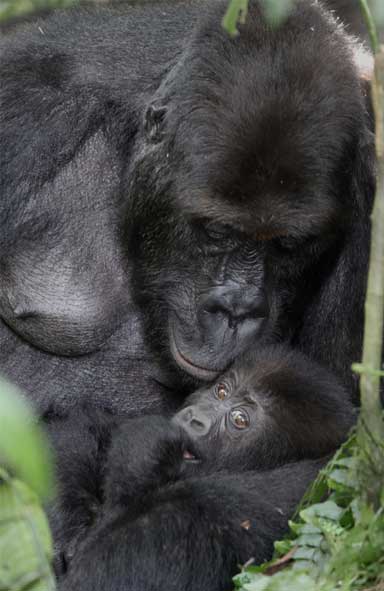
The new policy would allow US companies to buy conflict minerals freely — including gold, tin, tantalum, coltan and tungsten — without public disclosure. It would likely increase mining activities in the Congo basin, bringing in more workers that will hunt bushmeat to survive.
Trump’s memorandum would nullify the Conflict Mineral Rule for two years. The rule was passed with bipartisan support from Congress in 2010 as part of the Securities and Exchange Commission’s Dodd Frank Act. At the time, it was opposed by business interests, while human rights groups and environmentalists supported it.
The regulation as it currently exists requires companies to disclose conflict minerals that come from the DRC or an adjoining country. When it was passed, then-SEC Chairman Mary L. Schapiro said, “In adopting this statute, Congress expressed its hope that the reporting requirements of the securities laws will help to curb the violence in the eastern Democratic Republic of the Congo.”
The Trump memorandum’s reasoning for the proposed rule suspension is that it has led to “some job loss” in the past. The administration did not respond to requests for comment from Mongabay.
African nations, however, immediately expressed concern: “This might ultimately lead to a generalized proliferation of terrorist groups, trans-boundary money laundering and illicit financial flows in the region,” the International Conference on the Great Lakes Region (ICGLR) told Reuters. The ICGLR includes 12 African member states.
Counting Grauer’s gorillas
In the 2016 survey — the largest ever conducted for Grauer’s gorillas — park staff, local people and scientists led by the Wildlife Conservation Society (WCS) and Fauna & Flora International combed 7,450 square kilometers (nearly 3,000 square miles) to count the animals in the eastern part of the Congo, the only place they live. Researchers then used statistical analysis and computer modeling to estimate population size.
Their finding sparked international news coverage and a triage reaction from the conservation community.
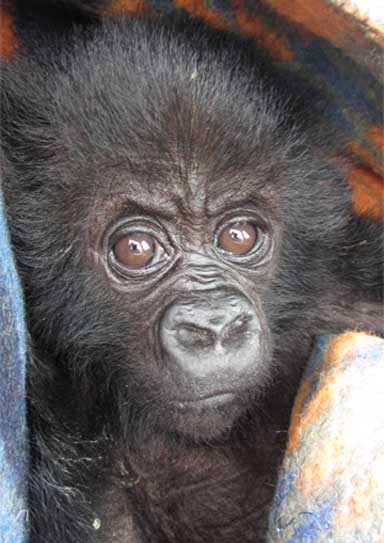
Within months, Grauer’s status was changed by the International Union for Conservation of Nature (IUCN) to the red-alert last stage before extinction in the wild: Critically Endangered.
Grauer’s joined three other gorilla subspecies on the IUCN list: the western lowland (G. g. gorilla) and Cross River gorillas (G. g. diehli), along with the other and far more famous eastern gorilla subspecies, the mountain gorilla (G. b. beringei), which attracts tourists from around the globe who come to see them in the Virunga Mountains.
All gorillas are now Critically Endangered.
“Most people have never heard of [Grauer’s gorillas], and [yet] they might be the first great ape to go extinct,” says Sonya Kahlenberg, who directs the Gorilla Rehabilitation and Conservation Education Center (GRACE), the world’s only sanctuary for orphaned Grauer’s gorillas.
Catastrophic decline
Back in 1994 when the Wildlife Conservation Society surveyed Grauer’s gorillas (in what was then Zaire), researchers estimated a population of 17,000.
But then in April of 1994, the Hutu ethnic majority in neighboring Rwanda launched a murderous campaign against the Tutsi minority, a genocide that pushed some two million refugees across the border into Zaire and Uganda. Many took refuge in national parks and forests, and the Democratic Forces for the Liberation of Rwanda and other militias set up operations there. Many survived on bushmeat, sparking what has become an ongoing gorilla “ecocide.”
The DRC government distributed arms to local communities to fight back. Many people fled. Forests became a major casualty — illegally logged both for fuel and the timber market. Hunting was rampant because of a deadly combination of hungry people and readily-available guns. Rangers and other law enforcement were forced to abandon national parks and other protected lands. The forests turned into slaughter grounds.
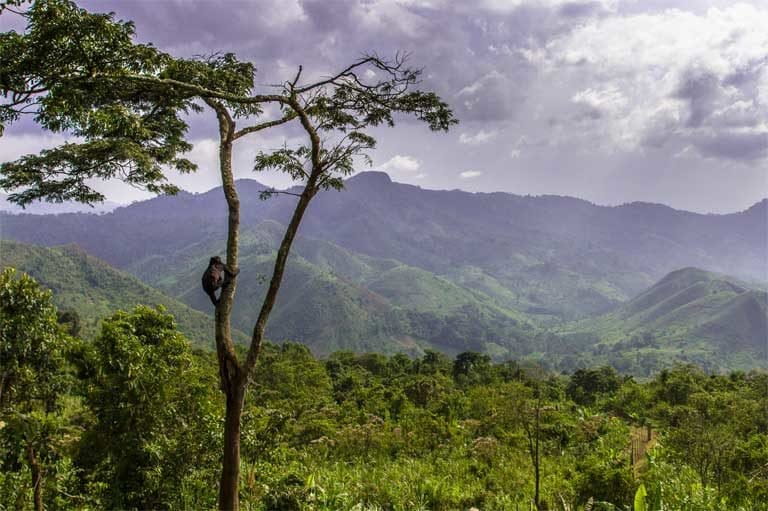
The stocky Grauer’s gorilla became a popular target. They are easy to track, moving on the ground in groups, and the animals provides lots of meat per bullet: they’re the world’s largest primate, with an average male weighing in at about 400 pounds. The largest tower six-feet three inches and weigh 600 pounds.
Conflict minerals stir the pot
By the time the war was declared over in 2003, some 5.4 million people were dead. But conflict still reigns in the eastern DRC — the Grauer’s homeland — fueled by a quest for the region’s abundant minerals.
Although the country has the world’s second lowest GDP, it’s considered to be the richest in natural resources, with mineral deposits worth at least $24 trillion, according to the nonprofit World Without Genocide. That includes an estimated $28 billion worth of gold and a vast supply of columbite-tantalite, or coltan, coveted for its use in electronics.


Exploitation of these riches has attracted hoards of artisanal miners, unscrupulous corporations, the military and corrupt government officials. Insecurity has flourished. But the greatest threat comes from more than 70 heavily armed militias, says Damien Caillaud, who is research director for the Dian Fossey Gorilla Fund’s Grauer’s gorilla program in DRC and a professor at the University of California, Davis.
Many of the militias control “conflict mineral” mines that have become the equivalent of fiefdoms, existing beyond government control, sometimes employing slave labor, and using profits to buy weapons and to support ongoing armed struggle.
Miners now operate deep within DRC national parks as well as in unprotected forests — the places where some gorilla groups managed to survive the civil war, and some of the last areas where Grauer’s gorillas live. The Belgium-based International Peace Information Service has documented more than 1,000 mines in the region, nearly all of them illegal.
The rogue miners present the greatest threat to Grauer’s ultimate survival.
It is illegal under national and international law to kill, capture or trade in either live gorillas or their parts and products. But armed groups and miners are hunting the apes at an astonishing rate, and at the same time, laying waste to the land, reducing lush rainforest to polluted, muddy moonscapes.
People, in close proximity to the great apes, also pose a pathogenic threat: gorillas are so closely related to homo sapiens that they are susceptible to human respiratory infections and other illnesses. The common cold can kill a gorilla.
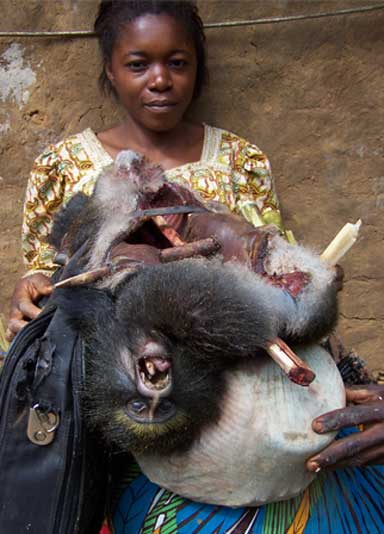
Gorillas snared
A US-based organization, Gorilla Doctors provides care, when possible, for gorillas stuck in snares. One hopeful note amidst the carnage: more Congolese veterinary students are training in great ape medicine than ever, a discipline requiring a specialized skill set nearly as complex as caring for a human.
Killing one gorilla can have large collateral damage, ultimately causing the deaths of four or five others, says Caillaud, who explains why. Ninety percent of Grauer’s gorillas live in groups dominated by just one male, the silverback leader. Hunters generally target him, both because he’s the biggest, with the most meat, and because he’ll attack to protect his family. If he’s killed, the group disbands. No babies will be born until females find a new group to join. For those that already have a baby, it might not survive: a silverback may kill another male’s offspring, as lions do.
Rescuing orphans
There was no place to care for young Grauer’s gorilla orphans that were seized by wildlife authorities until 2010. That’s when the GRACE sanctuary was founded in the DRC with the goal of raising orphaned gorillas and teaching them the skills they need to survive in the forest as a new family. The first four gorillas were airlifted to GRACE on a helicopter operated by the United Nations peacekeeping force in the DRC.
Orphans require significant care and often suffer from a variety of psychological and physical trauma. In 2011, for example, a 17 month-old male was discovered in a village where he had been illegally offered for sale. He was too young to be weaned, but had been given no milk and was fed only cassava for months — which is not gorilla food. When “Lubutu” arrived at GRACE, he was severely malnourished, had lost much of his hair, and was weak and dehydrated. But he’s one of the lucky ones; he survived and is thriving.


Today, GRACE cares for 14 Grauer’s gorillas, ranging from a two year-old toddler to a 16 year-old adult. The apes live in forest habitat in a surrogate family group where the older gorillas take on mothering roles, carrying and protecting newcomers. Human contact is kept at a minimum.
“Gorillas are social animals and we see orphans turn around quickly once they are reconnected with gorillas. They need each other as much as they need emergency care,” says Kahlenberg.
One reason GRACE is so successful at saving orphans, she explains, is that the facility partners with some of the world’s best zoos, whose gorilla experts train and advise the all-Congolese sanctuary staff. Zoos are consulted via frequent Skype calls, and experts have made 63 separate trips to GRACE since 2010.
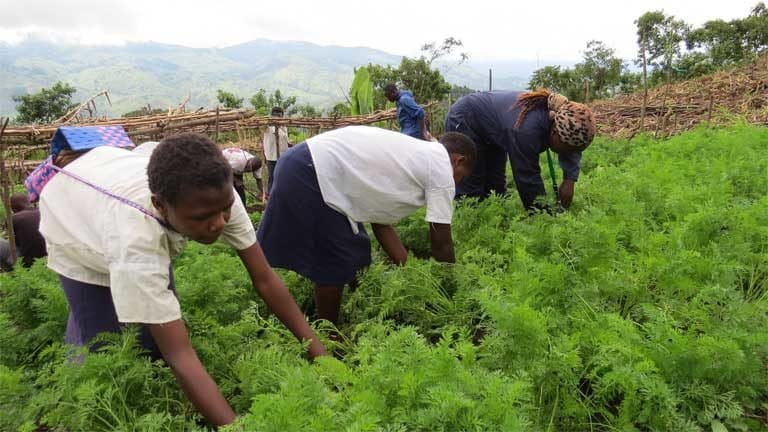

The region suffered some of the worst atrocities during the war, and almost everyone on the GRACE staff lost a family member during the conflict or after.
But the local community wants to move forward and is strongly committed to conservation. GRACE recently started a farm to grow food for the gorillas, says Kahlenberg, and every week about 40 kids show up after school to help weed and care for the crops. “I get so much hope from the people here!” she says.
With fewer gorillas now left in the wild, the sanctuary arrival rate is dropping. Last year, it received just one. The goal is to eventually reintroduce at least some gorillas to the wild, aiding isolated forest populations. GRACE has pinpointed one potential release site. But this is uncharted territory: nobody has ever sent captive Grauer’s gorillas back into the wild.
Wild gorillas do accept changes to their family groupings, reveals Kahlenberg, “but we don’t know how much is group-learned. We don’t know how the [sanctuary-raised animals] will react around a wild silverback. There are so many question marks.”


Protection and research: a risky business
Defending wildlife in the DRC is an extremely dangerous business. Access to these remote areas by law enforcement agencies, including national park service rangers or environment ministry personnel, is very difficult and risky. More than 200 park guards have been murdered over the last 20 years defending wildlife. The two most recent victims are Oscar Mianziro and Munganga Nzonga Jacques, who were ambushed in separate incidents by armed militias in Kahuzi-Biega National Park in 2016.
Many of those who have lost their lives fighting to conserve gorillas, elephants and other animals, had large families of their own, with eight, nine, ten kids, says Stuart Nixon (who works now as the Africa Field program coordinator for the Chester Zoo, UK). Those murders not only impact the families, but also the tight knit village communities where the men lived. “It’s quite humbling,” says Nixon. “You don’t often see that kind of dedication in the West, let alone in the developing world.”
Lawlessness and violence in the DRC has made it nearly impossible to study Grauer’s gorillas. As a result, much of what scientists “know” has been extrapolated from a half-century of research on mountain gorillas living in the nearby Virunga Mountains within the DRC, Rwanda and Uganda.

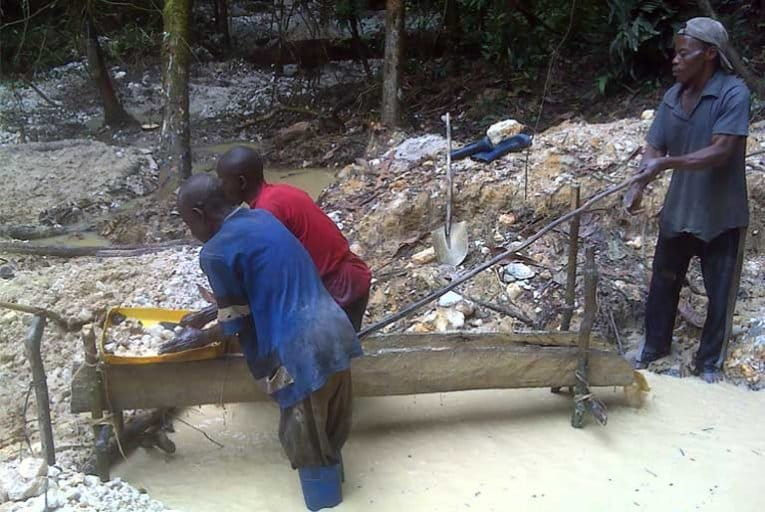
G. b. graueri was named for Rudolf Grauer, an Austrian zoologist who worked in Africa at the turn of the 20th century. He was the first to recognize this great ape as a distinct subspecies. While these animals resemble their mountain gorilla relatives, their limbs are longer, they have shorter hair, and they live at lower altitudes, from 1,900 feet to 9,500 feet above sea level.
This last distinction is important, notes Caillaud, because habitat significantly shapes behavior. That means that mountain gorilla research isn’t 100 percent relatable: the size and use of habitat, for example, can differ between lowland and upland gorilla subspecies. So does diet — researchers know that Grauer’s rely more heavily on fruits than their high-mountain dwelling cousins. These differences can sharply impact great ape social systems and habits.
Despite the constant risk of violence, researchers including Andy Plumptre (a biologist with WCS), Williamson, Nixon and others have continued working in the DRC rainforests for years.

Nixon contacted eminent field biologist George Schaller before a major trip to ask him about his research, field work that dated to 1959 — the first on-the-ground study of Grauer’s gorillas. Using the maps Schaller shared with him, Nixon located about 15 groups that were living in the exact same locations they’d been in more than a half-century before. “They were surrounded by thousands of square miles of forest, but they hadn’t expanded their range,” says Nixon. “We don’t know why.”
Nixon’s 2005 study produced some disturbing results: “We were starting to realize that there were big areas where [Grauer’s had been] in the 1960s — and they were gone,” he says. New sub-populations that his team discovered that year were hunted out by 2010. “We had a feeling that the decline was catastrophic. But you have to think about what’s left,” he says.
Those working to conserve Grauer’s gorillas — government officials, park guards, conservationists and local community members — came together in 2012 to draw up a Conservation Action Plan. It identified cooperative strategies to build sustainable community livelihoods, and defined roles and collaborations for constituents, including the underfunded Ministry of Environment and Congolese Wildlife Authority, tasked with protecting DRC wildlife.
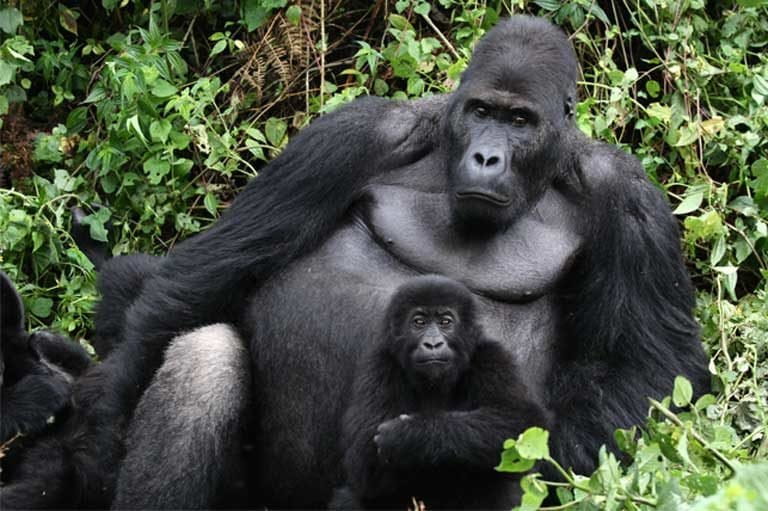
The consortium realized the need to quantify the severity of the Grauer’s decline with a broad survey. From 2013 to 2015, huge teams, often numbering 10-15 people, roamed the rainforest on physically challenging expeditions. Many surviving gorilla groups live in nearly inaccessible places, some as much as 30 miles from the nearest village or drivable road. All gear and rations had to be carried in on people’s backs, and security was a constant concern.
That exhaustive survey confirmed the continued, drastic decline of Grauer’s gorilla and led directly to the IUCN’s reclassification of the subspecies as Critically Endangered.
Points of light
“It’s possible that this terrible period is slowly coming to an end,” says Liz Williamson with surprising optimism. “In some places [national] park guards have regained control.”
She points to one relative success in an area key to the gorillas’ survival: the highland sector of Kahuzi-Biega National Park, site of the first-ever gorilla tourism in the 1970s. Before the civil war, this area was home to about 270 Grauer’s, a population that was halved by the slaughter.
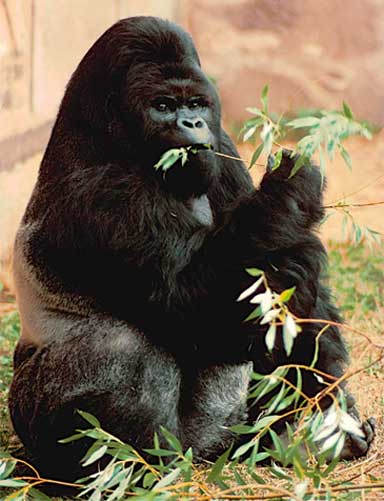
Areas of the park that are now relatively stable have been secured through dedicated, cooperative efforts between the Congolese government; the country’s parks authority (ICCN); Fauna & Flora International, WCS and other nonprofits; park guards (working beside the military); along with local communities. Kahuzi-Biega has seen some level of protection since 2003, says Nixon. Today the population of G. b. graueri in one part of the park is back up to about 200 individuals.
There is also hope for gorillas in remote regions such as Usala forest, at the heart of the eastern Congo’s 30,000 square kilometer (11,600 square mile) Maiko-Tayna region. Nixon’s team investigated anecdotal reports from Schaller and confirmed the Grauer’s presence in 2007. Since the area is very far from roads or settlements, there is a chance the great apes could survive here over the long term.
“Despite all the pressure, this proves that with focus and targeted resources, these successes are possible,” Nixon says.
The Dian Fossey Gorilla Fund has run a field station in the isolated heart of Grauer’s territory since 2012, in unprotected forest that lies between reserves. The facility’s Congolese staff patrols and collects gorilla data, and works closely with eight families who own vast tracts of land. Together, they are conserving gorillas and other wildlife. The families are poor villagers, not rich property owners, but they have chosen to control and reduce human activities on their land. As a result, wildlife is slowly increasing. “In just a few years, protection has had a detectable impact,” reports Caillaud.
About 25 percent of Grauer’s gorilla habitat first mapped by George Schaller had been razed by 2008. But today, even though some populations are isolated, there is still plenty of rainforest left. Though conservationists note that with growing human population, that won’t be the case forever.
So efforts are underway to protect key forest areas, with 2016 bringing a big success on that front. A new multiple-use protected area was created that benefits both wildlife and people — the Itombwe Natural Reserve, which stretches from lowlands to mountains and is one of the most biodiverse in Africa.



Consumer choices can help save gorillas
Few people realize when they buy electronics that the supply chain for those items can stretch deep into African rainforests. Parts for these products may come from mines that are run by ruthless militias and can contain “blood coltan.”
The insatiable international hunger for Playstations, laptops and cell phones — if not adequately regulated — contributes to insecurity, threatens the safety of local people and is killing gorillas and other animals. If the Trump administration’s presidential memorandum again allows US companies to buy conflict minerals freely, without public disclosure, the gorillas — and many communities — will face even greater danger as mines expand.
“I’d hope this makes people think about the supply chain for this equipment,” says Williamson, commenting on the real cost of conflict minerals. It comes down to consumer choices: if people care about African communities and great apes, “they should pressure the manufacturers and find out if they’re getting materials from credible, legitimate sources, which is difficult in DRC.” Even when mining operations are legal, supply chains may rely on militia that act as middlemen, she warns.
Conservationists note that consumers can help by upgrading electronics less frequently.
The stakes are high: Few Grauer’s gorillas exist in captivity, Kahlenberg concludes. And if this great ape becomes extinct in the wild, it will be effectively lost forever.
FEEDBACK: Use this form to send a message to the author of this post. If you want to post a public comment, you can do that at the bottom of the page.


